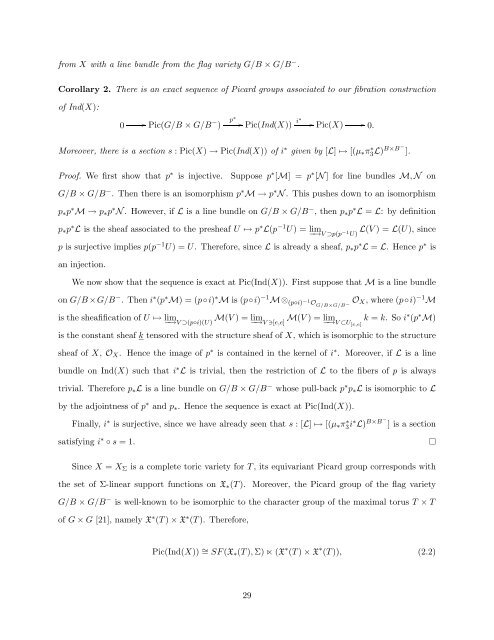Equivariant Embeddings of Algebraic Groups
Equivariant Embeddings of Algebraic Groups
Equivariant Embeddings of Algebraic Groups
You also want an ePaper? Increase the reach of your titles
YUMPU automatically turns print PDFs into web optimized ePapers that Google loves.
from X with a line bundle from the flag variety G/B × G/B − .<br />
Corollary 2. There is an exact sequence <strong>of</strong> Picard groups associated to our fibration construction<br />
<strong>of</strong> Ind(X):<br />
0 Pic(G/B × G/B − )<br />
p ∗ Pic(Ind(X)) i∗ Pic(X) 0.<br />
Moreover, there is a section s : Pic(X) → Pic(Ind(X)) <strong>of</strong> i ∗ given by [L] ↦→ [(µ ∗ π ∗ 3 L)B×B− ].<br />
Pro<strong>of</strong>. We first show that p ∗ is injective.<br />
Suppose p ∗ [M] = p ∗ [N ] for line bundles M, N on<br />
G/B × G/B − . Then there is an isomorphism p ∗ M → p ∗ N . This pushes down to an isomorphism<br />
p ∗ p ∗ M → p ∗ p ∗ N . However, if L is a line bundle on G/B × G/B − , then p ∗ p ∗ L = L: by definition<br />
p ∗ p ∗ L is the sheaf associated to the presheaf U ↦→ p ∗ L(p −1 U) = lim −→V ⊃p(p<br />
L(V ) = L(U), since<br />
−1 U)<br />
p is surjective implies p(p −1 U) = U. Therefore, since L is already a sheaf, p ∗ p ∗ L = L. Hence p ∗ is<br />
an injection.<br />
We now show that the sequence is exact at Pic(Ind(X)). First suppose that M is a line bundle<br />
on G/B ×G/B − . Then i ∗ (p ∗ M) = (p◦i) ∗ M is (p◦i) −1 M⊗ (p◦i) −1 O G/B×G/B − O X, where (p◦i) −1 M<br />
is the sheafification <strong>of</strong> U ↦→ lim −→V ⊃(p◦i)(U)<br />
M(V ) = lim −→V ∋[e,e]<br />
M(V ) = lim −→V ⊂U[e,e]<br />
k = k. So i ∗ (p ∗ M)<br />
is the constant sheaf k tensored with the structure sheaf <strong>of</strong> X, which is isomorphic to the structure<br />
sheaf <strong>of</strong> X, O X . Hence the image <strong>of</strong> p ∗ is contained in the kernel <strong>of</strong> i ∗ . Moreover, if L is a line<br />
bundle on Ind(X) such that i ∗ L is trivial, then the restriction <strong>of</strong> L to the fibers <strong>of</strong> p is always<br />
trivial. Therefore p ∗ L is a line bundle on G/B × G/B − whose pull-back p ∗ p ∗ L is isomorphic to L<br />
by the adjointness <strong>of</strong> p ∗ and p ∗ . Hence the sequence is exact at Pic(Ind(X)).<br />
Finally, i ∗ is surjective, since we have already seen that s : [L] ↦→ [(µ ∗ π ∗ 3 i∗ L) B×B− ] is a section<br />
satisfying i ∗ ◦ s = 1.<br />
Since X = X Σ is a complete toric variety for T , its equivariant Picard group corresponds with<br />
the set <strong>of</strong> Σ-linear support functions on X ∗ (T ). Moreover, the Picard group <strong>of</strong> the flag variety<br />
G/B × G/B − is well-known to be isomorphic to the character group <strong>of</strong> the maximal torus T × T<br />
<strong>of</strong> G × G [21], namely X ∗ (T ) × X ∗ (T ). Therefore,<br />
Pic(Ind(X)) ∼ = SF (X ∗ (T ), Σ) ⋉ (X ∗ (T ) × X ∗ (T )), (2.2)<br />
29
















